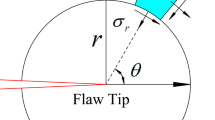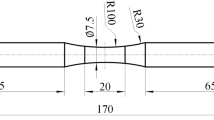Abstract
The micro behavior near the notch tip during load increasing was studied by using both plastic replication and optical microscope on mild steel specimen until the final stage of general yielding fracture at low temperature. Results show that a microcrack has already initiated at lower yield point, and the overall path of crack propagation appears to smear out such microcracks by the main crack starting from the notch root. Further, the ferrite grain size dependence of the brittle fracture stress and the temperature characteristics of the number of grains containing microcracks initiated prior to fracture are similar to that in unnotched (uncracked) ones established in the literature. Further, the effects of ferrite grain size and temperature on the crack tip opening displacement (CTOD) have been studied experimentally. The usefulness of the comparative study on cracked and uncracked specimens is discussed.
Résumé
Le comportement microscopique au voisinage de l'extrémité d'une entaille soumise à une charge croissante a été étudié en utilisant à la fois des répliques plastiques et un microscope optique sur des éprouvettes d'acier doux et ce jusqu'au stade final de la rupture par glissement généralisé à basse température. Les résultats montrent qu'une microfissure s'est déjà déclenchée au point de limite élastique inférieure et que le parcours général de la propagation de cette fissure apparait suivre de telles microfissures au départ d'une fissure principale démarrant à la pointe de l'entaille. On montre en outre que la liaison entre le grain ferritique et la tension de rupture fragile ainsi que les caractéristiques à la température du nombre de grains comportant des microfissures amorcées avant le rupture sont similaires aux relations constatées dans le cas d'éprouvettes non fissurées et non entaillées, dans la littérature. De plus, les effets du grain ferritique et de la temperature sur le déplacement d'ouverture de l'extrémité d'une fissure (COD) ont été étudiés expérimentalement. L'utilité de l'étude comparative sur des éprouvettes fissurées et non fissurées est discutée.
Similar content being viewed by others
References
G.T. Hahn, W.S. Owen, B.L. Averbach and M. Cohen, Welding Journal, 8 (1959) 367.
T. Kanazawa, S. Machida, S. Momota and Y. Hagiwara, Fracture, Proceedings 2nd International Conference on Fracture, Brighton, 1, Chapman and Hall (1969).
T. Yokobori and A. Otsuka, Experimental Mechanics, B.E. Rossi ed., Pergamon Press (1963) 353.
T. Yokobori, Proceedings of International Conference on Fracture Mechanics and Technology, Hong Kong, Noordhoff (1977).
Author information
Authors and Affiliations
Rights and permissions
About this article
Cite this article
Yokobori, T., Onishi, Y. Micro behavior at the notch tip during load increasing in brittle fracture beyond general yield. Int J Fract 13, 751–761 (1977). https://doi.org/10.1007/BF00034320
Received:
Revised:
Issue Date:
DOI: https://doi.org/10.1007/BF00034320




